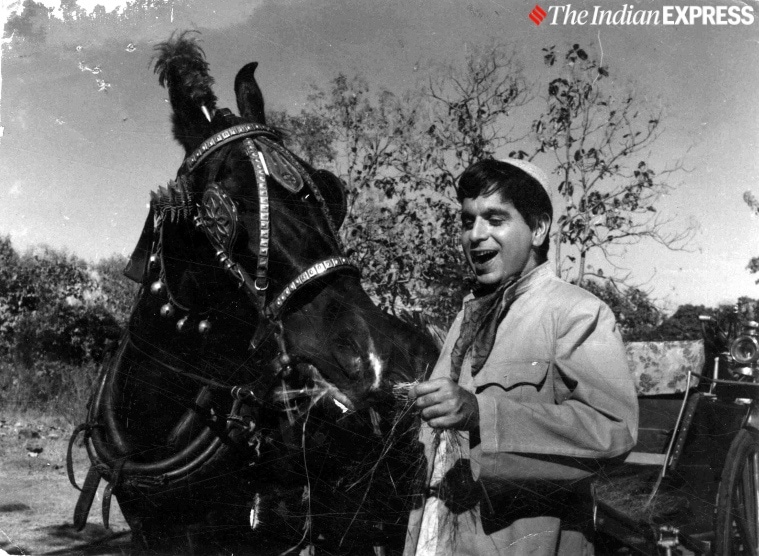In this weekly column, we revisit gems from the golden years of Hindi cinema. This week, we revisit BR Chopra’s 1957 film Naya Daur.
Naya Daur, literally translated as the ‘New Era’, is the story of a village that’s standing on the precipice of the promise of development but amid the assurance of a so-called better future, the villagers question why these promises of the future riches, are taking away their “do waqt ki roti” in present day.
Released in 1957, BR Chopra’s Naya Daur talks about the disturbing casualties of the rampant industrialisation that is projected as the wave of the future. Naya Daur opens with a quote by Mahatama Gandhi that best encapsulates its core message. “Dead machinery must not be pitted against the millions of living machines represented by the villagers scattered in the seven hundred thousand villages of India,” reads a part of the quote. The film questions this loss of employment in those ‘seven hundred thousand villages of India.’
 Dilip Kumar’s Shankar ignites the spark of revolution in Naya Daur. (Photo: Express Archives)
Dilip Kumar’s Shankar ignites the spark of revolution in Naya Daur. (Photo: Express Archives)
Naya Daur is set in an almost utopian village where everyone’s employed – either as a mill worker or as a tonga-puller. The mill owner, played by Nazir Hussain, treats his employees as equals and vehemently believes that the relationship between an employer and employee is horizontal, not vertical. Things take a steep turn when he goes for a pilgrimage and his city-bred son Kundan, played by Jeevan, takes his place. This is where the conflict between modern India and rural India starts taking shape as Kundan can see the value of his father’s business, but can’t see the value of his loyal workforce.
The introduction of a machine in the mill renders half the population jobless. The film’s protagonist Shankar, played by Dilip Kumar, takes it upon himself to negotiate with Kundan. Tonga-puller Shankar realises the importance of unity and is acutely aware that if one domino falls in this peaceful temple of a village, chaos will ensue. Soon after, Kundan introduces a lorry for tourists, in place of the age-old tonga. This threatens the employment of the other half of the village, which makes the villagers fear the extraordinary power of machines even more.
Naya Daur captures the spirit of a young country that is trying its best to keep its head above the water. A country that believes that moving with the times is the golden route to a better future but doesn’t really know what to do with its labour force that has been its backbone for all these years. Watching this film in 2021, one realises that in many ways, we are still struggling with the same problems, albeit with different titles. The film’s core struggle is the huge disparity between the haves and the have-nots. In Naya Daur, the conflict between man and machine doesn’t pit one against the other but rather encourages society to tread a middle path. In a significant scene in the film, Dilip Kumar’s Shankar stresses that neither he, nor the villagers, have anything against the machines. They just want the educated folk to come up with a way for them to not lose their employment.
The film’s final act builds up to a direct competition between hard labour and modern machinery, a race between the humble tonga and the lorry. It is in this portion that the film emphasises the power of unity that can create a revolution. The entire village gets together to build a new road, and a bridge, singing “Saathi Haath Badhana” which is no less than a war cry. Naya Daur is a 64-year-old film but a sequence in this portion rings so true even in 2021 that it feels like we haven’t missed a day. The film’s villain gets a God’s statue buried in the ground just so villagers mistake it as “devi maa ka sthaan” and stop building the new road. The manipulation of villagers, in the name of God, makes for a small episode here but is probably the most relatable bit. The politicisation in the name of God isn’t new for us Indians but seeing that not much has changed in our country, leaves you a bit disappointed.
Naya Daur raises a relevant question, how do you race ahead in the age of revolution but keep your citizens employed and well-fed? While it does not offer a direct resolution, it encourages us to find a middle path, which we are still trying to find, 64 years on.
The film is surely one of BR Chopra’s finest works with some brilliant performances by its cast – Dilip Kumar, Vyjayanthimala, Ajit and Jeevan. With songs like “Yeh Desh Hai Veer Jawano Ka”, which has continued to be a part of our cultural zeitgeist, thanks to bandwallahs, and romantic numbers like “Maang Ke Sath Tumhara” and “Ude Jab Jab Zulfe Teri”, Naya Daur’s music by OP Nayyar, with lyrics by Sahir Ludhianvi has stood the test of time. The film was written by Akhtar Mirza and is a masterclass in capturing the nerve of the nation, but doing so without being preachy and a relevant example of the same is the introduction of the love triangle in the film. The love triangle triggers the main conflict here, but it is evident that it’s used only as a tool to get to the core story.
Naya Daur is the story of the upcoming era, the premonition of change that can shake the foundation of society, and while society has been through many overhauls since 1957, the threat of the next step is just as unnerving.
Bollywood Rewind
Naya Daur is streaming on YouTube and ShemarooMe (Black & White) and Prime Video (Coloured).